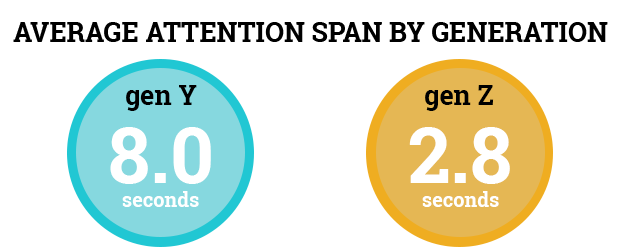You don’t need an MBA to start practicing solid ethical marketing practices in study abroad today. Here are 7 concepts to help every study abroad advisor, practitioner, and decision maker connect more authentically and effectively with students.
Why is this important? Studies have shown that Generation Z has an attention span of 2.8 seconds on average. This doesn’t mean they won’t pay close attention to relevant information — but it does mean it’s more important than ever to send clear and concise messages.

1.) Speak to “some one”, not everyone.
It’s tempting to cast the net wide and blast out an announcement about a new scholarship, program, or information session. The reality is that only some students are eligible for the scholarship, right for the program, or able to come to an information session.
Let go of your own FOMO (“fear of missing out”) when it comes to reaching students and make a discipline and habit of speaking primarily to specific groups of students.
2.) Say a little a lot and a lot a little.
It’s common for study abroad advisors to complain about students not reading anything, but when was the last time you took 10, 5, or even 3 minutes to read through a dense email or message word for word? Realizing that the world has moved on from long-winded emails and wordy online communication helps to empathize with the feelings students are having as well.
The truth is, students DO read content that speaks to them and gets to the point. Opt for bite-sized high-value content more frequently, like through social media, short emails with only one point to make, or a weekly newsletter rather.
For the rare occasion where it makes sense to bundle long form communication together (think, visa application instructions), create a concise statement up front about why sticking with the entire document is valuable.
3.) Segment your audience before communicating.
Marketing professionals have simple ways of segmenting their audience. Study abroad professionals can take the same categories and apply them!
- Demographic segments: year in school, education level, financial aid status, gender
- Psychographic segments: readiness, personal concerns, motivations for going abroad
- Behavioral segments: study abroad alumni, majors/minors, student groups
- Geographic segments: urban, rural, in-state/out of state
The possibilities are endless and unique to each organization!
4.) Go where they are, not where you prefer.
Maybe you hate SnapChat or Periscope or think Facebook is a blight on the face of the earth. It’s neither here nor there. When it comes to effectively engaging students, go where they are, not where you wish they would be. This goes for online spaces as well as on-campus spaces!
Work with student advocates, your marketing colleagues, and other social media influencers on campus to come up with a plan on how to go where students are.
5.) Target the message.
Get the right message to the right audience at the right time. Cultivating a consistent brand voice is particularly important when targeting your message because over time, a well-timed apropos message to a well-defined audience builds trust with students
6.) Create and share attention worthy content only.
Attention-worthy content can come from your office if all of the above principles are followed but it also comes from students, faculty, staff, alumni, and other stakeholders. Set some basic goals about how much content your office will create and curate. Strive to achieve a balance in sharing a diverse set of perspectives and voices that still maintain a consistent brand voice.
7.) Your audience decides what is attention worthy.
If the response is good, your content was engaging. If the response is not good, it was not and it’s that simple. Even if a marketing campaign falls flat with your audience, that’s okay! If you are able, seek quick feedback to modify the message for next time. Perhaps your assumptions about what is engaging may not have been correct or perhaps you need to try segmenting your student population a bit differently.
And a few final words…
Marketing is really the art and science of engagement with a clear and transparent goal. For study abroad offices, that goal is to inform students about education abroad opportunities and support the students who choose to go.





